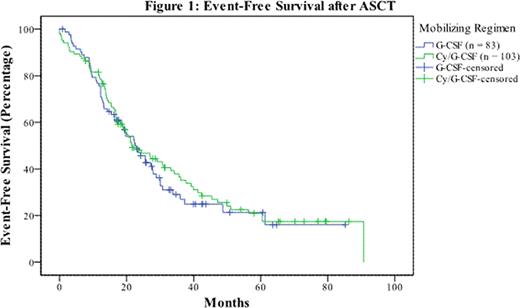Abstract
Abstract 4127
In the age of novel targeted agents, autologous stem cell transplant (ASCT) remains the standard of care for younger patients with newly diagnosed multiple myeloma (MM), offering similar treatment responses and overall survivals as standard chemotherapeutic agents but with the added benefit of a prolonged treatment-free period. Nevertheless, a standard of care for stem cell mobilization for ASCT has yet to be determined. Even in the era of new mobilization agents such as Plerixafor, Cyclophosphamide (Cy) and G-CSF combination remains the preferred mobilizing approach for patients with MM. Several studies have shown that Cy improves the stem cell yield at the expense of increased toxicity, but whether the administration of this chemotherapeutic agent pre-transplant has any impact on the long-term event-free and/or overall survival of myeloma patients remains controversial.
In this study, we present a retrospective analysis of 186 patients with newly diagnosed MM who underwent ASCT with high-dose melphalan 200 mg/m2 (HDM) between December of 2000 and 2008 at our Institution. Eighty-three patients were mobilized with single agent G-CSF and 103 patients received high dose Cy (4 gm/m2) and G-CSF combination. Patient characteristics were similar between the treatment groups, including: age, gender, disease stage, and disease status prior to transplant. However, toxicity post-mobilization with Cy/G-CSF was significantly higher compared with G-SCF alone, including: febrile neutropenia (23%), hemorrhagic cystitis (8%), GI toxicity (57%), re-hospitalization due to complications and transplant delay (14%).
The overall post-transplant toxicity was similar in the 2 groups, though the treatment related mortality was slightly higher in the Cy/G-CSF arm (4% versus 2%). Post transplant responses were not significantly different in the 2 groups, with 60% of patients achieving a VGPR or better after ASCT in the G-CSF group and 49% in the Cy/G-CSF group (p = 0.33). The median event-free survivals (EFS) for the Cy/G-CSF and G-CSF cohorts were 21.6 and 22.6 months, respectively, (p = 0.62) yielding no significant difference (Figure 1). Similarly, with a median follow up for surviving patients of 34.3 and 32.7 months, the median overall survivals were 68.2 and 62.3 months (p = 0.23) for the Cy/G-CSF and G-CSF cohorts, respectively (Figure 2). This retrospective analysis confirms that the addition of high dose Cy as part of the mobilizing regimen offers no improvement on the transplant outcome for patients with newly diagnosed myeloma and should therefore only be used in cases of difficult stem cell mobilization.
No relevant conflicts of interest to declare.
Author notes
Asterisk with author names denotes non-ASH members.



This feature is available to Subscribers Only
Sign In or Create an Account Close Modal